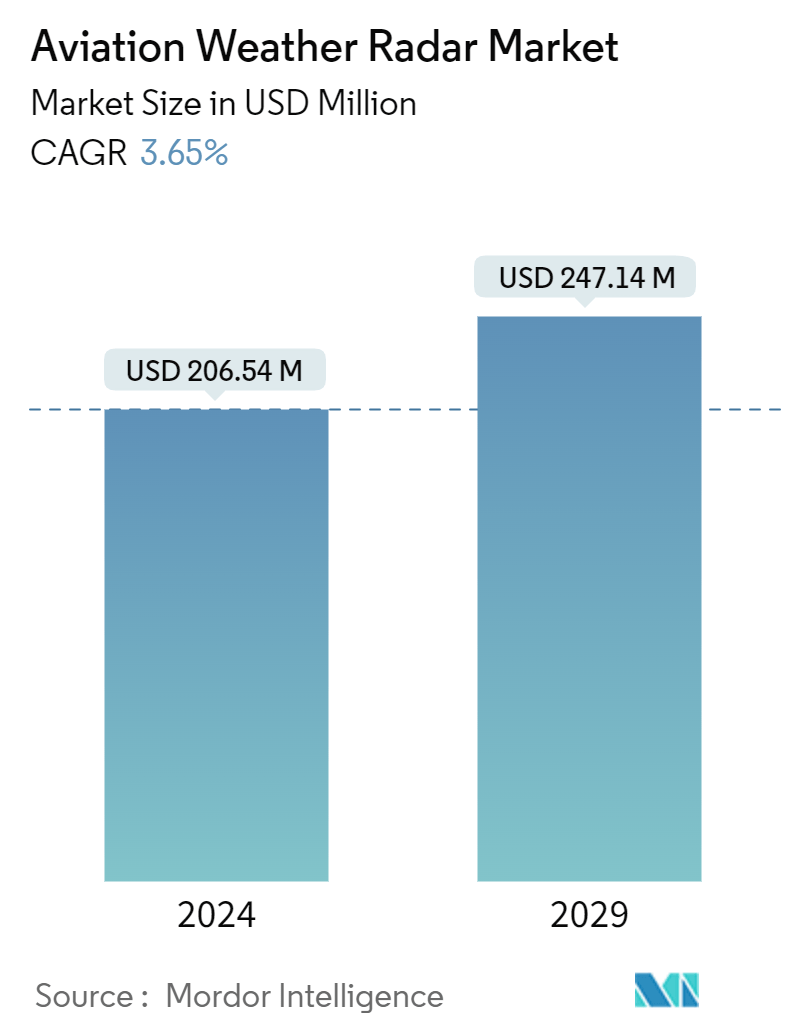Market Size of Aviation Weather Radar Industry

| Study Period | 2019 - 2029 |
| Market Size (2024) | USD 206.54 Million |
| Market Size (2029) | USD 247.14 Million |
| CAGR (2024 - 2029) | 3.65 % |
| Fastest Growing Market | Asia Pacific |
| Largest Market | Asia Pacific |
| Market Concentration | High |
Major Players
*Disclaimer: Major Players sorted in no particular order |
Aviation Weather Radar Market Analysis
The Aviation Weather Radar Market size is estimated at USD 206.54 million in 2024, and is expected to reach USD 247.14 million by 2029, growing at a CAGR of 3.65% during the forecast period (2024-2029).
The aviation weather radar market is experiencing a surge in demand for advanced radar systems, driven by the critical need for weather monitoring. Safeguarding aircraft from adverse weather conditions emerges as a key market driver. Instances of unexpected weather disturbances lead to aircraft disruptions and, in severe cases, damage, underscoring the urgency for airports to adopt weather radars.
Adopting state-of-the-art radar technologies, notably pulse-doppler radar, enables aircraft to navigate adverse weather conditions more efficiently and safely. Additionally, the industry is witnessing a notable shift toward lighter, more compact radar systems, offering improved fuel efficiency and lower maintenance costs.
However, the market faces challenges, including the high costs and complexities of radar systems and regulatory and environmental obstacles. Market players need to focus on R&D, innovation, and collaboration to overcome these challenges and stay competitive. While these hurdles could potentially hinder market growth, the rising demand from the commercial, general, and military aviation industries for advanced radar systems is set to drive the market positively during the forecast period.
Aviation Weather Radar Industry Segmentation
An aviation weather radar, also known as a weather surveillance radar (WSR), is a crucial installation in both aircraft and airports. Its primary function is to detect and track various weather phenomena, such as precipitation, and to forecast weather patterns, including rain, snow, and hail. Modern aviation weather radars can even gauge the movement and intensity of raindrops.
The aviation weather radar market is segmented by end user and geography. By end user, the market is segmented into airports and aircraft. The aircraft segment is further segmented into commercial, general, and military aviation. The report also covers the market sizes and forecasts for the aviation weather radar market in major countries across different regions. For each segment, the market sizes and forecasts are provided in terms of value (USD).
| End User | |||||
| Airport | |||||
|
| Geography | |||||||
| |||||||
| |||||||
| |||||||
| |||||||
|
Aviation Weather Radar Market Size Summary
The aviation weather radar market is poised for steady growth, driven by the increasing demand for advanced radar systems essential for monitoring weather conditions and ensuring aircraft safety. The adoption of cutting-edge technologies, such as pulse-doppler radar, is enabling more efficient navigation through adverse weather, while the industry is also witnessing a shift towards lighter and more compact systems that offer enhanced fuel efficiency and reduced maintenance costs. Despite challenges like high costs and regulatory hurdles, the market is expected to benefit from the rising demand across commercial, general, and military aviation sectors. The global military aviation sector, in particular, is experiencing a surge due to geopolitical tensions and modernization efforts, further fueling the need for advanced radar systems.
Regionally, the Asia-Pacific market is anticipated to lead with the highest growth rate, driven by significant expansions in commercial aviation and airport infrastructure in countries like China and India. These nations are making substantial investments in airport developments and fleet procurements, which are expected to amplify the demand for aviation weather radars. Additionally, regional military procurements are contributing to market growth, with countries enhancing their weather radar capabilities. The market is dominated by key players such as Honeywell International Inc., Collins Aerospace, and L3Harris Technologies, who are expanding their product offerings to meet the diverse needs of aircraft manufacturers. Strategic contracts and technological advancements, such as Honeywell's IntuVue RDR-7000 system, are reshaping the competitive landscape and driving market expansion.
Aviation Weather Radar Market Size - Table of Contents
-
1. MARKET DYNAMICS
-
1.1 Market Overview
-
1.2 Market Drivers
-
1.3 Market Restraints
-
1.4 Industry Attractiveness - Porter's Five Forces Analysis
-
1.4.1 Bargaining Power of Suppliers
-
1.4.2 Bargaining Power of Buyers/Consumers
-
1.4.3 Threat of New Entrants
-
1.4.4 Threat of Substitute Products
-
1.4.5 Intensity of Competitive Rivalry
-
-
-
2. MARKET SEGMENTATION
-
2.1 End User
-
2.1.1 Airport
-
2.1.2 Aircraft
-
2.1.2.1 Commercial Aviation
-
2.1.2.2 Military Aviation
-
2.1.2.3 General Aviation
-
-
-
2.2 Geography
-
2.2.1 North America
-
2.2.1.1 United States
-
2.2.1.2 Canada
-
-
2.2.2 Europe
-
2.2.2.1 United Kingdom
-
2.2.2.2 France
-
2.2.2.3 Germany
-
2.2.2.4 Russia
-
2.2.2.5 Rest of Europe
-
-
2.2.3 Asia-Pacific
-
2.2.3.1 China
-
2.2.3.2 India
-
2.2.3.3 Japan
-
2.2.3.4 South Korea
-
2.2.3.5 Rest of Asia-Pacific
-
-
2.2.4 Latin America
-
2.2.4.1 Brazil
-
2.2.4.2 Rest of Latin America
-
-
2.2.5 Middle East and Africa
-
2.2.5.1 Saudi Arabia
-
2.2.5.2 United Arab Emirates
-
2.2.5.3 Egypt
-
2.2.5.4 Rest of Middle East and Africa
-
-
-
Aviation Weather Radar Market Size FAQs
How big is the Aviation Weather Radar Market?
The Aviation Weather Radar Market size is expected to reach USD 206.54 million in 2024 and grow at a CAGR of 3.65% to reach USD 247.14 million by 2029.
What is the current Aviation Weather Radar Market size?
In 2024, the Aviation Weather Radar Market size is expected to reach USD 206.54 million.

